Railing Contractor in Orange County
Enhance your home with an expert railing contractor in Orange County. We offer custom railing installation services using wood, cable, vinyl, and metal material designed for safety and style.
Need Expert Railing Services In Orange County
- Which railing material options fit your homes aestehtic?
- How do coastal conditions in Orange County affect railing durability?
- Where can I get custom wood railings that meet building codes?
- How can I find a dependable railing contractor for safe, durable, and code-compliant installations?
- What railing colors or finishes are trending for outdoor spaces?
- How do I prevent my railing from wobbling or detaching?
Safe and Stylish Railing Systems In Orange County
We Install Railings That Meet Code With no Clunky Hardware or Shortcuts
Get A Free Estimate
Submit below for a no-pressure, no-obligation quote.
Orange County Railing Contractor
Looking for expert railing building services in Orange County? We specialize in custom railings for residential properties, including decks, staircases, and balconies, designed for safety and style. Whether you need a new installation or repairs, our skilled team delivers durable, code-compliant solutions tailored to your home.
Common problems we solve: wobbly or loose railings, rotted posts and balusters, code violations (height, spacing, load requirements), missing or broken sections, rusted metal railings, improperly anchored systems, and structural issues which can include inadequate post connections, missing blocking between posts, corroded fasteners, improper baluster spacing, insufficient handrail support, or deteriorated materials that compromise safety and fail building inspections. From simple repairs to complete railing replacements, we diagnose the root cause and deliver lasting solutions that restore both safety and aesthetic appeal.
Common Railing Problems & Expert Solutions in Orange County
Homeowners throughout Orange County frequently face railing issues that require professional carpentry expertise. Here’s how we solve the most common problems:
Wobbly or Loose Deck Railings
Loose railings indicate inadequate post connections or failed fasteners. We inspect post-to-joist connections, remove undersized or corroded lag bolts, and install structural-grade fasteners with proper blocking. For deck railings, we use through-bolts with backing plates that distribute load across multiple rim joists rather than relying on surface-mounted screws. Posts are sistered or replaced if rot or splitting compromises integrity. We add diagonal knee braces or metal angle brackets where codes require additional lateral support. All connections are torqued to manufacturer specifications and tested for movement before final inspection.
Rotted Railing Posts and Balusters
Wood rot occurs where moisture penetrates unprotected end grain or poorly sealed connections. We remove compromised posts down to solid wood, cut back affected sections, and install rot-resistant materials like pressure-treated lumber rated for ground contact or composite alternatives. For Trex Transcend or TimberTech railing systems, we use their proprietary composite posts with aluminum reinforcement sleeves that eliminate rot entirely. Post bases receive flashing details that shed water away from connections. We seal all end cuts with waterproof sealant and use stainless steel fasteners that won’t corrode. Balusters are replaced with properly spaced alternatives—wood, composite, aluminum, or cable—depending on aesthetic preference and maintenance requirements.
Railing Code Violations (Height, Spacing, Load Requirements)
California building codes require deck railings minimum 36 inches high (42 inches for commercial), with balusters spaced no more than 4 inches apart to prevent child passage. We measure existing railings against current IRC/CBC standards, identify violations, and retrofit systems to meet code. This often involves adding height extensions, installing intermediate balusters, or completely rebuilding sections. Handrails must be graspable (1.25-2 inches diameter) and continuous along stair runs. We ensure all railings meet 200-pound concentrated load requirements by upgrading post connections and adding structural blocking. Pool deck railings receive special attention for self-closing gate hardware and climbing deterrent features required by California’s pool barrier laws.
Inadequate Post Connections and Structural Support
The most critical failure point in any railing system is the post-to-deck connection. We reject surface-mounted posts secured only with lag screws—these fail lateral load testing. Instead, we use notched posts that sit directly on top of rim joists with through-bolts, or install blocking between joists to create solid backing. For elevated decks, we add diagonal bracing from posts to deck framing for triangulation. Trex and TimberTech composite railing systems include engineered post mounting brackets rated for structural loads—we install these per manufacturer specs with all required fasteners. Metal posts receive base plates through-bolted to deck structure. Every post connection is load-tested before adding rail sections.
Rusted or Corroded Metal Railings
Coastal Orange County’s salt air accelerates corrosion of steel and aluminum railings. We assess whether railings can be refinished or require replacement. Surface rust on powder-coated aluminum can often be sanded, treated, and repainted. Structural corrosion requires replacement with marine-grade materials—316 stainless steel for coastal properties, or powder-coated aluminum with minimum AAMA 2604 coating. For cable railing systems, we use only stainless steel cable (not galvanized steel which rusts) with stainless hardware throughout. Metal post bases receive proper flashing and drainage to prevent water accumulation. We recommend bi-annual inspection and maintenance for all metal railings within 5 miles of the coast.
Improper Baluster Spacing (4-Inch Sphere Rule)
Building codes prohibit gaps larger than 4 inches anywhere in railing infill to prevent child entrapment. We measure existing spacing with a 4-inch sphere gauge, identify violations, and add intermediate balusters. For horizontal cable railings, we ensure cables are spaced 3 inches apart maximum and tensioned to prevent sagging that could create gaps. Glass panel systems must use tempered safety glass with proper edge support. We explain the reasoning behind spacing requirements and show homeowners how inspectors test for compliance. Adding balusters to existing railings requires matching wood species and finish or transitioning to a complementary material like metal pickets or cable for aesthetic consistency.
Stair Railing Code Compliance Issues
Stair railings have different requirements than deck railings: handrails must be 34-38 inches above stair nosings, graspable along the entire run, and return to walls or posts at both ends (no protruding hazards). We install code-compliant stair railings with proper height, continuous handrails, and balusters meeting the 4-inch spacing rule on raked angles. For open stair sides, we add intermediate stringers or blocking to support guardrails. Interior stair railings receive wall-mounted handrails with returns, while exterior stairs get weather-resistant systems. Handrail brackets are installed into wall studs (never just drywall) using structural screws rated for dynamic loads. All stair railings meet 200-pound load requirements at any point.
Deck Railing Doesn’t Match Deck Material
Mismatched railing systems create visual disconnect and maintenance challenges. For Trex composite decking, we install Trex Transcend or Select railing systems in matching colors—Gravel Path, Rope Swing, Vintage Lantern, or custom combinations. TimberTech decking gets paired with TimberTech RadianceRail or Impression Rail in coordinating profiles. These composite railing systems include universal top rail, square balusters, post sleeves, and post caps that match deck board colors precisely. For wood decks, we use matching wood species (cedar deck equals cedar rails) or contrast intentionally with black aluminum or stainless cable. Proper material pairing increases property value and eliminates the DIY look of mixed-material systems.
Cable Railing Sag or Improper Tensioning
Cable railings require proper tensioning to prevent sagging that violates the 4-inch sphere rule. We install stainless steel cable (1/8-inch or 3/16-inch diameter) through drilled posts with swaged fittings or mechanical tensioners at one end. Cables are tensioned to 200-350 pounds using calibrated tension gauges—not pulled tight by hand. Post spacing is limited to 4 feet maximum to prevent cable deflection. We use wood posts with routed channels or metal posts with pre-drilled holes for clean installation. All cable ends receive proper termination with swaged studs or mechanical fittings—never crimp sleeves which fail under load. Cables are spaced 3 inches apart vertically and re-tensioned after initial settling period.
Premium Railing Systems We Install
Our railing installations utilize industry-leading composite and metal systems engineered for California’s coastal climate:
Trex Railing Systems:
Trex Transcend Railing (premium composite with aluminum reinforcement) Trex Select Railing (value composite with wood-alternative aesthetics) Trex Signature Aluminum Railing (powder-coated metal in black, bronze, white) Universal top rail with routed channel for infill options (glass, cable, balusters) Matching post sleeves, post caps, and decorative accessories 25-year fade and stain warranty
TimberTech Railing Systems:
TimberTech RadianceRail (composite with grooved top rail for lighting integration) TimberTech Impression Rail (metal balusters with composite top rail) TimberTech Cable Rail Express (stainless cable system with composite posts) Matching colors to TimberTech decking lines (AZEK, PRO, Edge) Integrated LED lighting rail options Lifetime limited warranty on composite components
Cable Railing Components:
316 marine-grade stainless steel cable (3/32″, 1/8″, or 3/16″ diameter) Swaged cable assemblies with left/right thread tensioners Quick-connect cable rail kits for simplified installation Stainless steel post drilling jigs and cable spacing templates Powder-coated aluminum or wood post systems AGS Stainless and Feeney CableRail products
Wood Railing Materials:
Clear vertical grain cedar (naturally rot-resistant, weathers to silver-gray) Redwood heartwood (premium durability, rich color) Pressure-treated southern yellow pine (ACQ or Micronized Copper treatment) Hardwood options: Ipe, Cumaru, Tigerwood (exotic tropical hardwoods) Custom milled balusters, newel posts, and handrail profiles Exterior-grade wood stains and sealers (TWP, Sikkens, Penofin)
Metal Railing Systems:
Powder-coated aluminum (black, bronze, white, custom colors) Wrought iron (custom fabrication available) Stainless steel (304 for inland, 316 for coastal properties within 5 miles of ocean) Glass panel systems (tempered safety glass with aluminum channels) Pre-fabricated railing sections and custom welded designs
Fasteners and Hardware:
Structural lag bolts and through-bolts (hot-dip galvanized or stainless steel) Hidden deck fasteners (CAMO, Cortex, TigerClaw systems) Post-to-joist connection brackets (Simpson Strong-Tie, USP Structural Connectors) Handrail brackets (ADA-compliant, wall-return designs) Stainless steel cable fittings and tensioners Trex and TimberTech proprietary mounting hardware
For Orange County’s coastal climate, we prioritize corrosion-resistant fasteners and composite materials that eliminate rot, rust, and maintenance. Stainless steel hardware (304/316 grade) is standard for properties within 5 miles of the coast. Composite railing systems from Trex and TimberTech carry 25-year to lifetime warranties and require zero maintenance beyond occasional washing.
Whether you’re dealing with code violations, structural failures, or outdated materials, our Orange County railing contractor brings 26 years of expertise to deliver lasting, code-compliant solutions backed by premium materials from Trex, TimberTech, and industry-leading manufacturers.
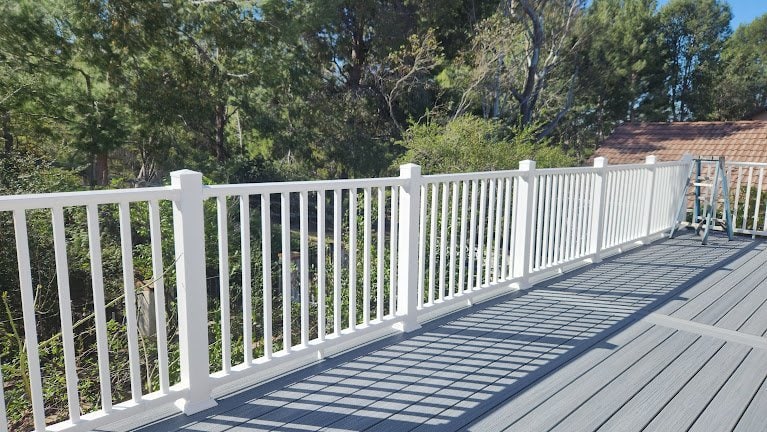
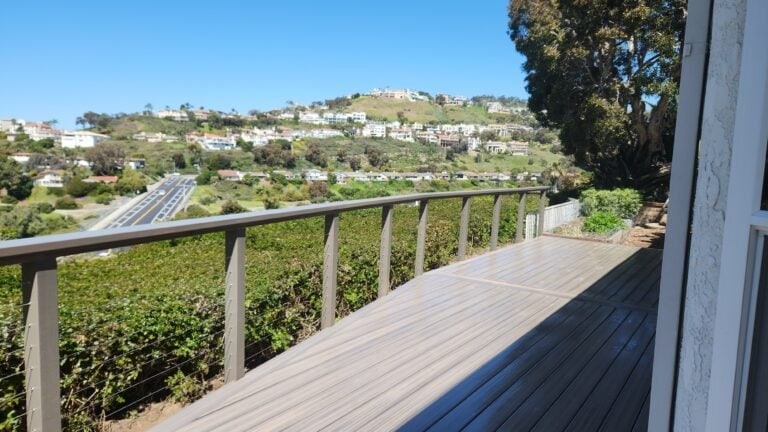
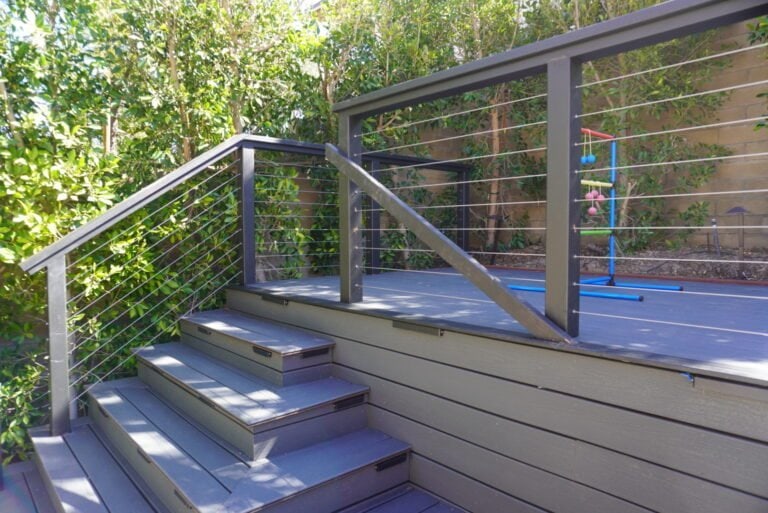
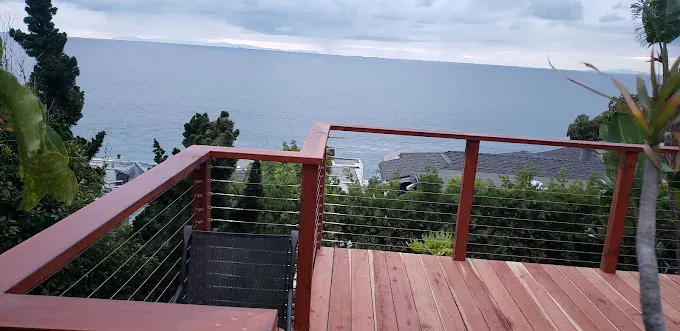

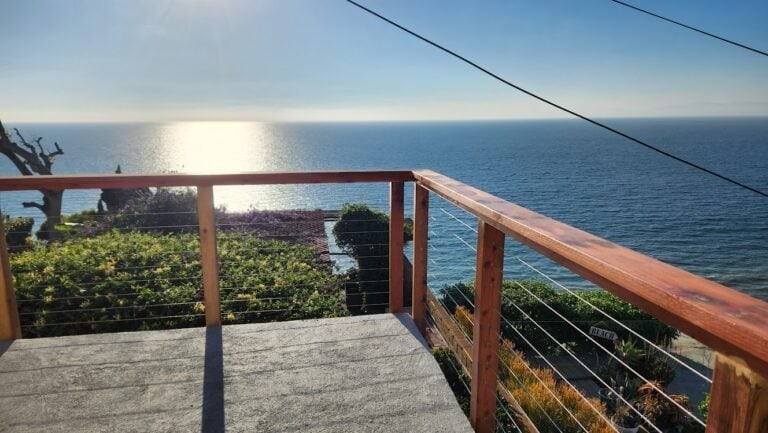
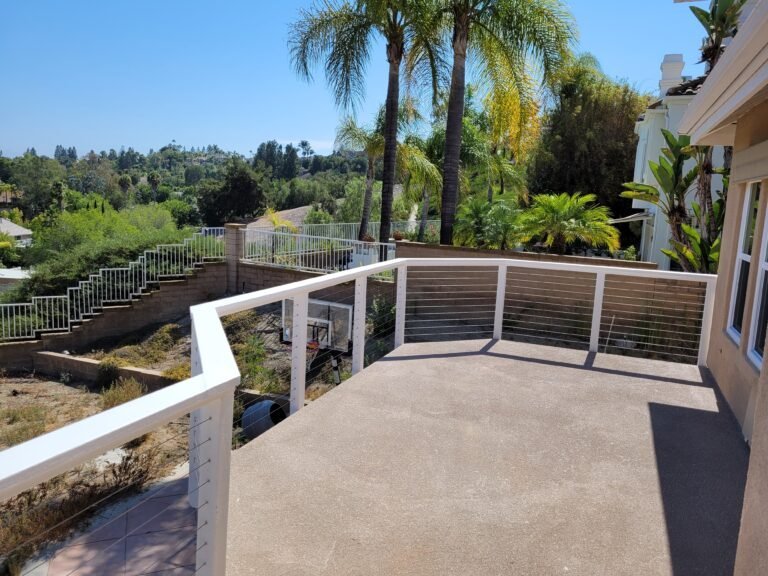
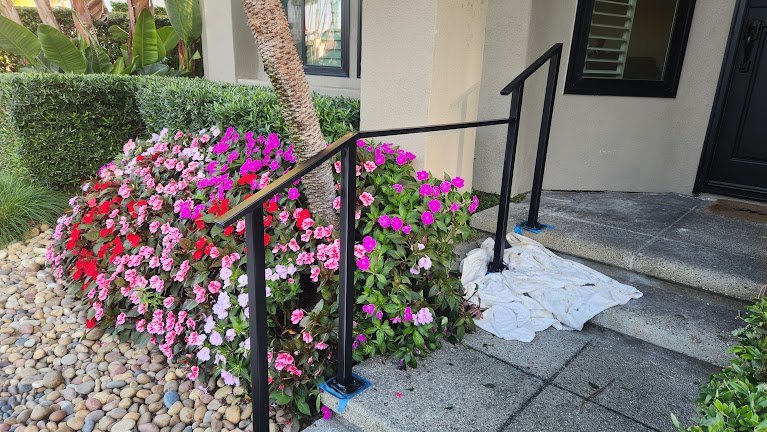

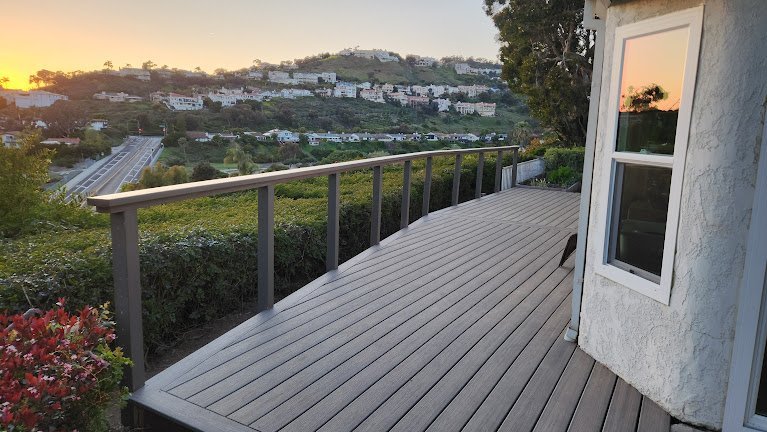

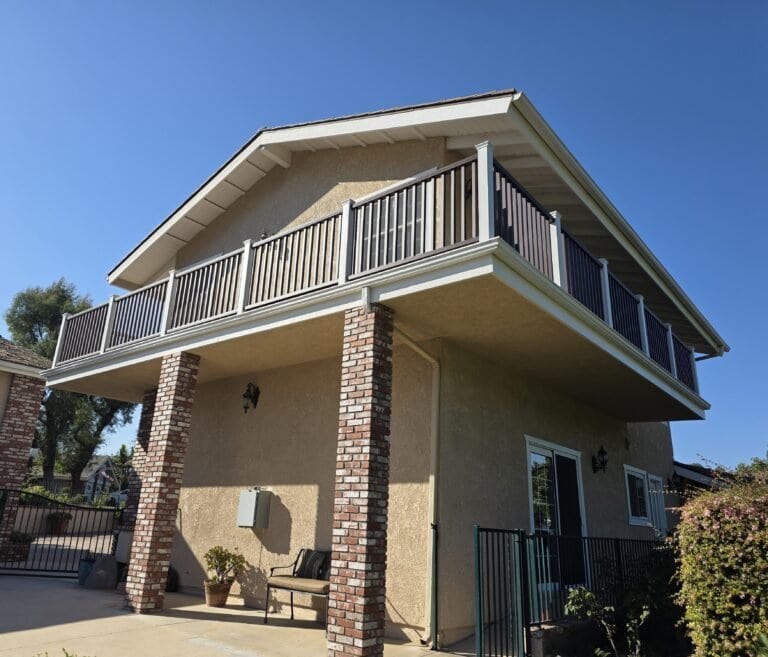
Code-Compliant Construction
A reliable railing contractor builds to California safety codes, ensuring every railing is structurally sound, properly anchored, and meets height and spacing requirements. This protects homeowners from liability and keeps occupants safe.
Custom Design & Material Options
The best contractors offer custom-built railings tailored to your home’s style and environment. We work with wood, metal, and composite materials to ensure durability, weather resistance, and a seamless aesthetic fit.
Precision Installation & Repair
Top professionals handle both new installations and repairs with attention to structural integrity. We correct issues like wobbling, rot, or misalignment using proven techniques and high-quality fasteners for long-lasting results.
Railing Design
Our custom railing designs combine safety with style, offering a variety of materials and styles to complement your home or business. Whether you prefer cable, classic wood, composite, vinyl, or metal, we provide high-quality, durable options tailored to meet your aesthetic and functional needs. Enhance the look of your space while ensuring stability and security with our expert railing solutions.

Cable
Stainless steel cable railing systems offer great design flexibility and complement a wide range of architectural styles. Their sleek, minimal lines make them a striking choice for both classic and modern homes, often blending in so well they almost disappear. The final appearance of a cable railing system depends heavily on the framing materials and the method of installation. They’re low-maintenance, weather-resistant, and good for providing unobstructed views.

Composite or Vinyl
Both are strong, durable, and low-maintenance. Unlike wood, they resist damage and never need painting or staining. They are both easy to clean and offer a finished appearance. Generally vinyl is cheaper than composite.
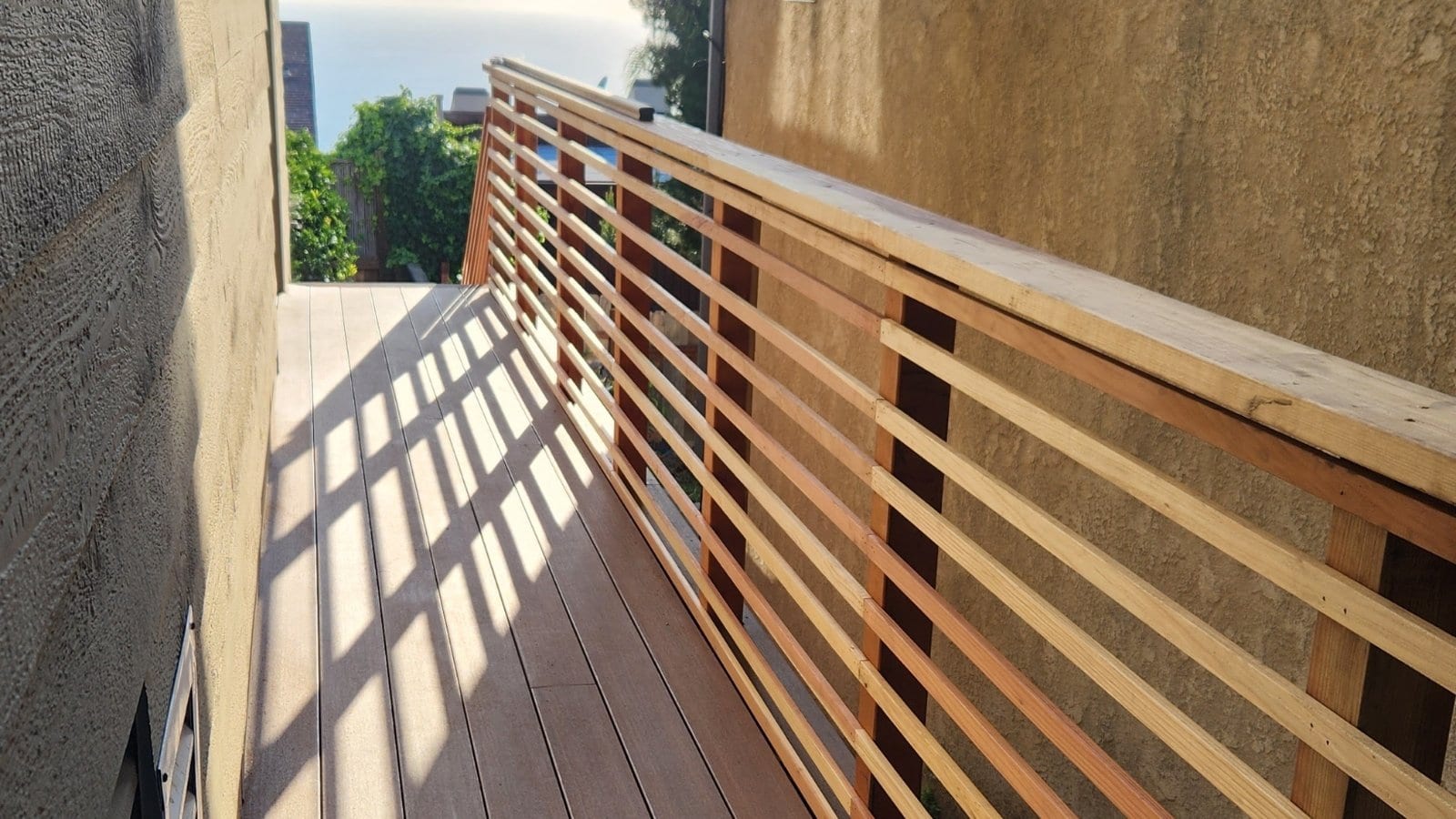
Wood
Traditional deck railings typically feature wooden posts, pickets or boards, and top and bottom rails. They’re a popular option due to their affordability and ease of construction. Custom wood railings crafted by professionals can enhance the look of premium decking, with decorative balusters and post caps that match your home’s style. However, wood railings may obstruct views more than other types and require regular maintenance. With proper care, they can last over a decade.

Metal
While other materials can be visually appealing, metal—especially steel—offers a distinct edge in style. Its strength allows for a wide range of design possibilities, from clean, minimalist looks to detailed, artistic patterns. These structural advantages give homeowners the freedom to select a railing system that reflects their personal aesthetic.
Check Out Our Reviews
EXCELLENTTrustindex verifies that the original source of the review is Google. This is the second time I have hired OC Renovation Group for Carpentry work. Recently they reinforced my fence with new hardware and built me a new gate and it came out great.Trustindex verifies that the original source of the review is Google. Received really good service and I am satisfied with them.Trustindex verifies that the original source of the review is Google. Farid did a great job for my slide door frame fixing!Trustindex verifies that the original source of the review is Google. Recently hired OC Renovations to tear out a 30 year old deck and replace with a new Trek deck. Working with Farid was a very pleasant experience. He was creative with this approach to the job, showed up everyday and completed the job in a very timely manner. I interviewed five companies and his pricing was very competitive and his enthusiasm and honest attitude is what sold me. I highly recommended OC Renovations.
How Our Railing Service Works & What To Expect
You Are Just Three Steps Away From your Railing Construction.
Step 1: Consultation & On-Site Evaluation
Contact our railing installation experts in Orange County to discuss deck, stair, or patio railing needs. We review height and spacing requirements, attachment points, structural support, accessibility considerations, ergonomics, and material suitability This will ensuring that the railing system we propose will be secure, durable, and ensuring safety and compliance with building codes
Step 2: Material Selection & Custom Railing Design
Our team designs custom railing solutions that integrates seamlessly with your existing structures, meets durability requirements, and enhances aesthetics. We guide you through high-quality materials—wood, metal, cable, or glass. We create a custom railing design that matches your deck, stairs, or patio while ensuring proper height, spacing, and anchoring per California building codes.
Step 3: Expert Installation & Final Walkthrough
Our skilled railing contractor installs your railing with precision, securing posts, aligning panels, and verifying stability. We address site-specific challenges such as uneven surfaces or existing structures, ensuring a flawless finish. After installation, we conduct a final walkthrough with you to confirm safety, alignment, and aesthetics, and provide maintenance guidance to keep your railing looking and performing its best for years to come.
If you’re thinking about new railings or repairs, we’d love to help make your Orange County home safer and more beautiful. Reach out when you’re ready, and we’ll work with your schedule to find the best solution for you. Planning on more? We often install them alongside custom deck builds for a cohesive outdoor finish.